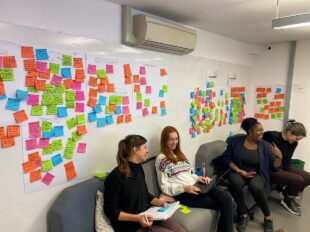The pandemic hit, and before we knew it, we were conducting all our research remotely. We cancelled our fieldwork and travel, and rearranged all our one-to-one interviews, focus groups and testing to be done via video calls or telephone.
The switch was sudden and unplanned, but we quickly adjusted. Across government we shared guides and tips for successfully conducting research remotely. We replaced sticky notes and markers with online boards. Now three years on we are finding that remote has become the norm and it has many benefits. Unless there is a clear advantage to in-person research we are now more often opting for remote methods rather than booking facilities and travelling to interviews.
Conducting research is a key part of user centred design. It’s how we understand user needs and draw up requirements for design, and once we have mocked up designs it’s how we test them and check that they are easy to use and understood by users. It’s also a key method to understand problems and issues that may arise with our services.
Traditionally many user research methods are done in person: conducting usability testing in a laboratory and getting users to do tasks on services to test whether they work / meet user needs, doing home visits to interview users about different topics to inform service design, or carrying out observational research to watch how users engage with our services.

Should we be doing more in person research?
To help us answer this question we decided to do a one-day workshop where we booked a facility allowing each member of the team to conduct in person testing and then workshopped the advantages and disadvantages of doing in person vs remote research. We specifically focused on testing in a laboratory environment as a lot of the team had not experienced this part of the role as they had joined during or post pandemic. These are some of the points we came up with:
Advantages of in person:
- Team engagement: Facilities for testing often have the option of a backroom where the wider team can watch the research (often on a TV screen or through a two way mirror) – this may be interaction designers, content designers, service designers. This can really help with engagement and get the whole team more involved with the findings. It allows for active discussion and ideation – designers may mock up new screens or wording while research is taking place.
- Better for accessing those with low digital skills – in person means there is no need for the participant to share their screen in testing, join prototypes or log onto a video call eliminating potential access barriers.
- May pick up more context / understanding in person – can read body language and expressions more easily when the person is in front of you. In addition to this in person can allow us to test in the users natural environment that they would do the task / use the service (not in a laboratory) – at HMCTS we often test with court staff and it is essential that we understand their work environment and context to get an accurate understanding of their behaviour, so we spend a lot of time in court.
- Works well if there is a mix of online and offline – can see what user is doing, the whole picture not just what’s on their screen. This is especially useful if there are leaflets, notebooks or calendars being used in combination to complete tasks.
Discussion points
- What is most representative of ‘normal behaviour’? – when testing at a facility, participants have travelled to a new location and may feel a bit uneasy or nervous. Is it more reflective of natural behaviour when they are sitting in the comfort of their own home with their own devices sharing a screen?
- What is the best format for sensitive topics? – we were split on this one. We often do research with users going through life changing and difficult events and it’s important that they feel comfortable, so we were keen to get a better understanding of this. Behind a screen can feel more hidden or safe or less personal? While in person we may be able to build better rapport and get users to relax more? We may also pick up more subtle cues in person around how the user is feeling and what they are happy to share.
- Remote is quicker? – we usually try to cover a good distribution of the UK and not having to travel means we can do so more easily. During the start of the pandemic our team had a number of urgent projects that required quick gathering of insights, and doing research remotely allowed us to conduct interviews much faster and deliver findings that were used to shape decisions and changes that would not have been possible if conducting research in person. However on the flip side, in person can also speed up understanding of users and the design process as it can bring everyone together in a way that remote does not always encourage.
We all agreed that each project needs to be assessed on an individual level – the subject matter, the objectives and urgency. It often comes down to the balance of having it as close to real context / behaviour as possible and the advantage and cost of doing that.
If you’d like to join the conversation on returning to remote, please get in touch.
Find out more about being a user researcher, and register for job alerts from HMCTS.
